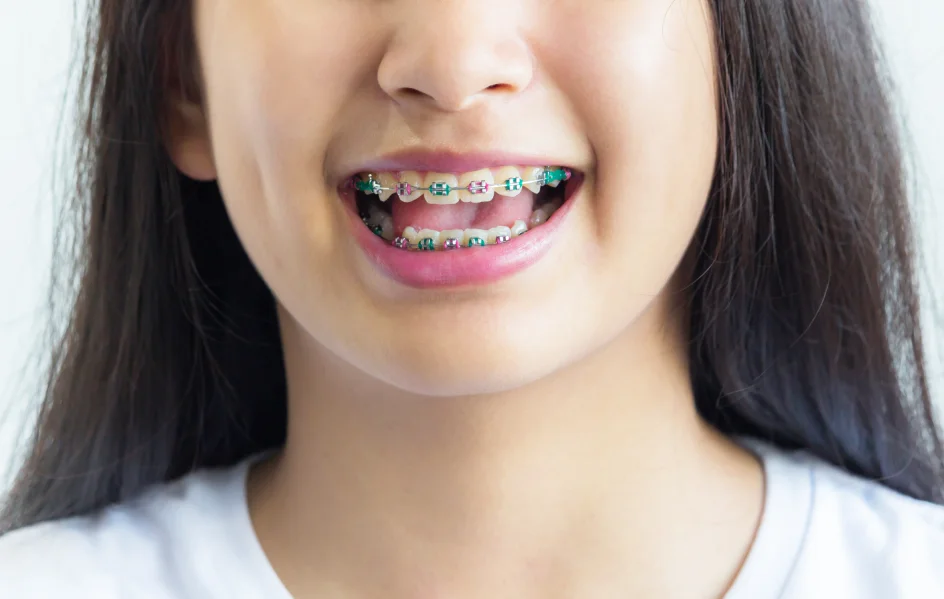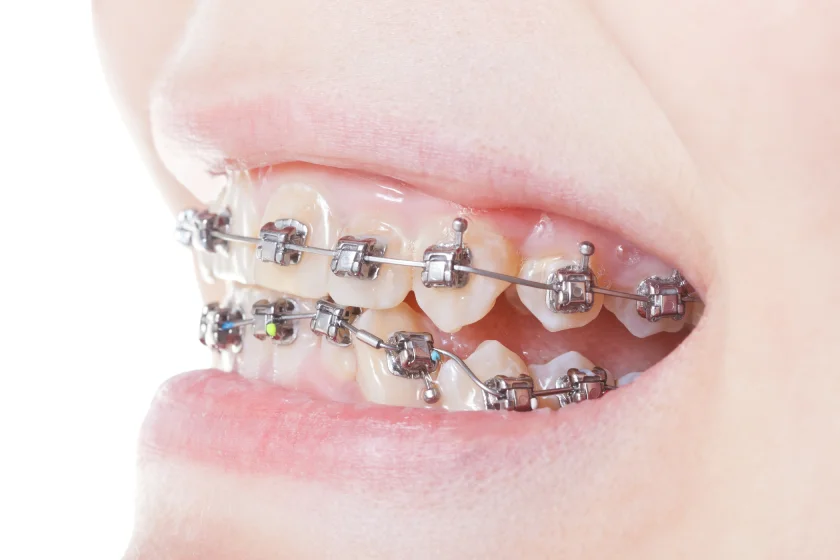
By the time most students hit their mid to late teens, their permanent teeth have fully erupted (save for wisdom teeth). That means that at this stage, the dentist has a comprehensive view of the patient’s bite, as well as an idea of how the bite will continue to develop.
It’s also at this stage that teens’ jawbones haven’t fully hardened yet. This means teeth are easier to move around, much easier than when teens reach their mid-twenties.
Starting braces at this stage helps guide proper jaw development and supports long-term oral and dental health. Plus, getting started early helps teens achieve that confident smile by the time graduation photos come around.
But early orthodontic treatment doesn’t just mean aligning crooked teeth for a more aesthetic facial profile. Fixing orthodontic issues also means fixing a patient’s bite alignment, straightening teeth so that they come into full contact with each other when the mouth is closed. This results in improved chewing function, even distribution of jaw forces, and, since teeth won’t be crowded, it also means patients can clean their teeth more thoroughly.
Key Takeaways
- Starting braces early matters. The mid to late teenage years are an ideal time to begin orthodontic treatment, as the teeth and jawbones are still developing.
- Every student’s needs are different. Consider factors such as cost, comfort, school activities, and your teen’s confidence when choosing a treatment.
- Better options come at higher costs. For example, self-ligating braces, braces that can move teeth much faster than traditional braces, cost much more than their traditional counterparts.
- Consultation is key. A dentist can recommend the most suitable braces plan that fits both your budget and your child’s academic routine.
Factors When Choosing Braces for Mid to Late Teens in School
Choosing the right one for students ensures not only early intervention in mouth and face development, but also an orthodontic journey that is harmonious with the academic and social demands of teenage life.
Here are a few things parents and teens often discuss at the dental clinic before starting their treatment plan.
Cost
Cost is one of the most crucial deciding factors, as parents also allocate funds for their kids’ education and day-to-day expenses.
As such, many clinics offer flexible payment plans, as well as back-to-school promos. So you can get started with your teen’s orthodontic treatment without too much strain on the wallet.
The cost of braces in Singapore can vary depending on the type, materials, and expertise of the dentist.
Metal braces are generally the most budget-oriented, making them a popular choice among students. While ceramic or self-ligating options cost more.
Compatibility with School Life
Between recess and the O-Levels, wearing braces shouldn’t feel like a full-time job.
Some braces, due to their high maintenance and friction, can get in the way of a normal school life. Some students can’t tolerate the mild discomfort that conventional braces bring, affecting their focus.
Sometimes, an orthodontist has to cut an orthodontic plan short due to the student’s affected school performance. To prevent such instances from occurring, parents should consider their child’s academic commitments before making a decision.
Child’s Self-Esteem
For some teens, metal braces are a badge of pride. For others, they’d rather keep things subtle with non-showy options.
While the ultimate goal is to get teens’ teeth to move into place, until that time comes, they shouldn’t have to worry about looking ridiculous and missing out on a good social life. A good orthodontic treatment plan should consider the patient’s self-esteem and not trample on it.
Length of Orthodontic Treatment Plan
Students have varying tolerances to extensive orthodontic care.
For example, some students love their braces and don’t mind wearing them. However, other students would want to get them off as soon as possible.
The length of treatment depends on the complexity of the misaligned teeth and the patient’s adherence to their orthodontic care routine.
However, the duration for which the patient has to wear their braces also depends on the type of braces themselves. Take, for example, self-ligating braces. These braces align teeth quicker than traditional braces due to their more continuous, gentle force.
Types of Braces Suitable for Teens
Taking into account the factors above, plus current popularity with early adolescent students, some suitable braces for teens include the following:
Traditional Metal Braces

The classic choice.
Traditional metal braces are still the most common and reliable student choice for braces. They’re as ubiquitous on campus as glasses and sweaters.
These braces use metal brackets and wires to gently guide teeth into alignment. Brackets are attached to the straightening archwire using tight elastic bands, which are replaced every orthodontic appointment.
Students may choose the colours of these elastic bands, adding another flair of campus expression.
Ceramic Braces

If your teen wants something more discreet, ceramic braces might be the way to go.
They work just like metal braces, but the brackets are tooth-coloured. However, due to this choice of material, they are more expensive than conventional braces.
Self-Ligating Braces

elf-ligating braces use a small clip instead of elastic ties to hold the wire in place.
This means there are no elastic bands for dentists to replace. The downside is that students don’t get to choose their braces’ colour.
However, this also means self-ligating braces have less friction, allowing them to apply much gentler forces when moving the teeth. Because of this continued, incremental force, self-ligating braces might move teeth much faster than metal braces. It’s an excellent solution for busy students who may want to be rid of braces as soon as possible.
Self-ligating braces also have a sleeker profile than conventional braces. They’re more “metal-looking”, which gives them a distinct style from conventional braces.
But out of the three options mentioned, self-ligating braces are the most expensive.
Orthodontic Treatments Not Very Suitable for Teens
While all orthodontic care ultimately aligns teeth to their ideal position, some issues may arise with the apparatus itself and how it fits into a student’s day-to-day life.
Some challenging options include:
Lingual Braces

Lingual braces are placed behind the teeth, completely hidden from view.
Sounds cool, right?
The very premise of these braces is that they’re discreet, making the person wearing them appear as if they don’t have any apparatus on at all.
But with conventional braces being a common school look, having noticeable braces isn’t really an issue.
Since lingual braces are placed behind the teeth, they can irritate the tongue, make eating more difficult, and are generally more challenging to adjust to than traditional metal braces. They’re also more expensive, all for the perceived benefit of hidden braces.
Book an Initial Consultation Today
Starting orthodontic treatment can be a huge financial leap. But it doesn’t have to be.
Many dental clinics in Singapore offer flexible payment plans to help families manage the cost of braces in Singapore comfortably.
MySmile Dental Group understands the importance that wearing braces brings to students’ dental health, budding self-confidence, and long-term oral health. We provide a wide range of orthodontic care solutions tailored to your teen and their busy academic commitments.
Whether you’re considering traditional metal braces, ceramic braces, or other dental services, discussing the available treatment plans with your dentist can help you explore your options and plan ahead.
Frequently Asked Questions
At what age should students start wearing braces?
Most students start wearing braces between 12 and 16 years old, once all their permanent teeth (except wisdom teeth) have erupted. At this age, their jawbones are still flexible, which makes tooth movement easier and treatment faster.
How long will my teen have to wear braces?
Treatment usually takes 18 months to 2 years, sometimes more. It depends on the complexity of the alignment issue and how closely your teen follows the orthodontist’s care instructions. Self-ligating braces may shorten this time slightly because of their continuous, gentle pressure.
Do braces affect school activities like sports or music?
For the most part, no. Students can continue sports and engage in musical activities, though it might take a few days to get used to speaking or playing wind instruments. Plus, your child may develop a different vocal profile due to their orthodontic apparatus. For contact sports, wearing a mouthguard is recommended to protect the braces, the teeth, and your child’s opponent.
What if my child feels self-conscious about wearing braces?
That’s perfectly normal! Many students now see braces as a common and even trendy part of school life. Some even customise their elastic bands with fun colours. For those who prefer a subtle look, ceramic braces can be ideal.
